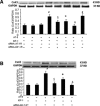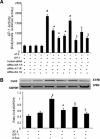Cross-talk between angiotensin II and IGF-1-induced connexin 43 expression in human saphenous vein smooth muscle cells
- PMID: 20731749
- PMCID: PMC3000445
- DOI: 10.1111/j.1582-4934.2010.01161.x
Cross-talk between angiotensin II and IGF-1-induced connexin 43 expression in human saphenous vein smooth muscle cells
Abstract
Vascular restenosis following coronary artery bypass graft can cause major clinical complications due to intimal hyperplasia in venous conduits. However, the precise underlying mechanisms of intimal hyperplasia are still unclear. We have recently reported that increased expression of connexin43 (Cx43) is involved in the proliferation of vascular smooth muscle cells (SMCs) in human saphenous vein (SV). In this study, we investigated the signalling transduction pathway involved in Cx43 expression and SV SMC proliferation. Angiotensin-II (AT-II, 100 ng/ml) increased AT-II receptor 1 (AT-1R) protein expression and insulin-like growth factor-1 (IGF-1) (100 ng/ml) up-regulated IGF-1 receptor (IGF-1R) protein expression in SV SMCs. Interestingly, AT-1R expression was also increased by IGF-1 treatment, and IGF-1R expression was increased by AT-II treatment, which was blocked by siRNA-IGF-1R and siRNA-AT-1R, respectively. Furthermore, the effect of AT-II and IGF-1 signal cross-talk i nducing up-regulation of their reciprocal receptors was blocked by siRNA against extracellular signal-regulated kinases 1/2 (Erk 1/2) in SMCs of SV. Moreover, AT-II and IGF-1-induced Cx43 expression via phosphorylation of Erk 1/2 and activation of transcription factor activator protein 1 (AP-1) through their reciprocal receptors in SV SMCs. These data demonstrate a cross-talk between IGF-1R and AT-1R in AT-II and IGF-1-induced Cx43 expression in SV SMCs involving Erk 1/2 and downstream activation of the AP-1 transcription factor.
© 2011 The Authors Journal compilation © 2011 Foundation for Cellular and Molecular Medicine/Blackwell Publishing Ltd.
Figures





References
-
- Anstadt MP, Franga DL, Portik-Dobos V, et al. Native matrix metalloproteinase characteristics may influence early stenosis of venous versus arterial coronary artery bypass grafting conduits. Chest. 2004;125:1853–8. - PubMed
-
- Huang B, Dreyer T, Heidt M, et al. Insulin and local growth factor PDGF induce intimal hyperplasia in bypass graft culture models of saphenous vein and internal mammary artery. Eur J Cardiothorac Surg. 2002;21:1002–8. - PubMed
-
- Dhume AS, Agrawal DK. Inability of vascular smooth muscle cells to proceed beyond S phase of cell cycle, and increased apoptosis in symptomatic carotid artery disease. J Vasc Surg. 2003;38:155–61. - PubMed
-
- Kwak BR, Mulhaupt F, Veillard N, et al. Altered pattern of vascular connexin expression in atherosclerotic plaques. Arterioscler Thromb Vasc Biol. 2002;22:225–30. - PubMed
-
- Sukhanov S, Higashi Y, Shai SY, et al. IGF-1 reduces inflammatory responses, suppresses oxidative stress, and decreases atherosclerosis progression in ApoE-deficient mice. Arterioscler Thromb Vasc Biol. 2007;27:2684–90. - PubMed
Publication types
MeSH terms
Substances
Grants and funding
LinkOut - more resources
Full Text Sources
Research Materials
Miscellaneous

